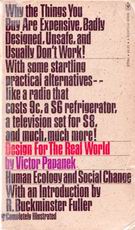
Design for the Real World
Human Ecology and Social Change
Papanek, Victor
Publisher: Bantam, New York, USA
Year First Published: 1970
Year Published: 1973
Pages: 378pp Price: $2.25 Resource Type: Book
Cx Number: CX7385
While two-thirds of the world's population lives in poverty, valuable human and natural resources are used to produce: fur-covered toilet seats, electronic nail polish dryers, diapers for parakeets, and mink-oil fertilizer for "the plant that has everything." Papanek discusses why the things you buy are expensive, badly designed, unsafe, and often don't work. He proposes alternative ways of thinking and alternative designs for safe, inexpensive, and desperately needed products.
Abstract:
-
Table of Contents:
Introduction, by R. Buckminster Fuller
Preface
Part One / Like It Is
1. What is Design?
A Definition of Design and the Function complex
2. Phylogenocide
A History of the Industrial Design Profession
3. The Myth of the Noble Slob
Design, "Art," and the Crafts
4. Do-It-Yourself Murder
The Social and Moral Responsibilities of the Designer
5. Our Kleenex Culture
Obsolescence, Permanence, and Value
6. Snake Oil and Thalidomide
Mass Leisure and Phony Fads in the Abundant Society
Part Two / How It Could Be
7. Rebel With a Cause
Creativity vs. Conformity
8. How to Succeed in Design Without Really Trying
Areas of Attack for Responsible Design
9. the Tree of Knowledge: Bionics
The Use of Biological Prototypes in the Design of Man-made Systems
10. Conspicuous Consumptives: Design and the Environment
Pollution, Crowding, Starvation, and the Designed Environment
11. The Neon Blackboard
The Education of Designers and the Construction of Integrated Design Teams
12. Design for Survival and Survival Through Design
What Can We Do?
Bibliography
Subject Headings


